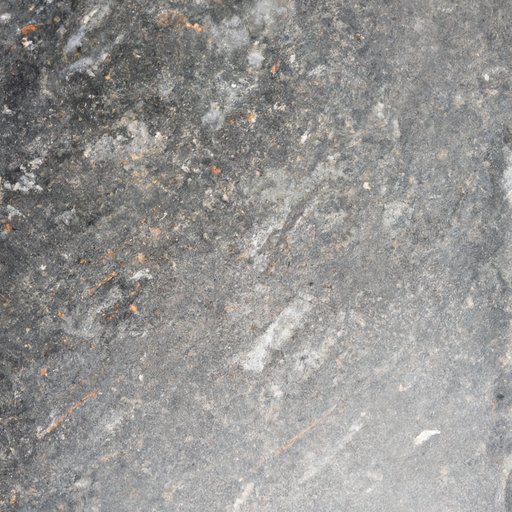Introduction
Granite is one of the most popular and versatile building materials used in construction projects around the world. Its widespread use has made it a household name, but what exactly is granite? Is granite a rock or mineral? In this article, we will explore the physical and chemical properties of granite to answer this question.
Overview of Granite: Is it a Rock or Mineral?
In order to answer the question of whether granite is a rock or mineral, it is important to first understand the definitions of rocks and minerals. Rocks are solid natural objects composed of various minerals. Minerals, on the other hand, are naturally occurring inorganic solids with a distinct chemical composition and crystalline structure.
Granite is an igneous rock, which means it was formed from molten magma deep beneath the earth’s surface. It is composed of quartz, feldspar, mica, and other minerals, which give it its characteristic speckled appearance. Granite is usually light-colored and has a coarse texture, although different varieties may have different colors and textures.
The chemical composition of granite varies depending on the minerals present in the rock. It is composed primarily of quartz (SiO2), feldspar (KAlSi3O8), and mica (KAl2(Si3Al)O10(OH)2). It also contains minor amounts of other minerals, such as hornblende, biotite, and tourmaline.
Exploring the Properties of Granite: Is it a Rock or Mineral?
In order to determine whether granite is a rock or mineral, it is helpful to examine its physical and chemical properties. Granite is known for its high compressive strength, making it ideal for use in construction and engineering projects. Its durability and weathering resistance also make it a popular choice for outdoor applications.
Granite is relatively low in porosity and permeability, which means it does not absorb water easily. This makes it resistant to staining and helps to maintain its appearance over time. Additionally, granite is highly abrasive, so it can withstand significant wear and tear over time.
Comparing Granite to Other Rocks and Minerals
Granite is classified as an igneous rock, which means it is formed from molten magma. As such, it shares many similarities with other igneous rocks, such as basalt and gabbro. Granite is also similar to sedimentary rocks, such as sandstone and limestone, in that it is composed of minerals. However, unlike sedimentary rocks, granite does not contain fossils.
Granite is also similar to certain minerals, such as quartz and feldspar. However, unlike minerals, granite is not composed of a single element. Instead, it is composed of several minerals, giving it a unique combination of physical and chemical properties.
Granite in the Geological Context: Is it a Rock or Mineral?
In order to answer the question of whether granite is a rock or mineral, it is important to consider its formation and classification. Granite is formed by the cooling and crystallization of molten magma, which occurs at depths of several kilometers below the earth’s surface. Over time, the magma cools and hardens, forming a solid mass of interlocking crystals.
Granite is classified as a plutonic igneous rock, which means it is formed from cooled magma deep beneath the surface of the earth. Plutonic igneous rocks are typically coarse-grained and composed of quartz, feldspar, and mica. Granite is one of the most common types of plutonic igneous rocks.
The Role of Granite in Construction: Is it a Rock or Mineral?
Granite has been used in construction for centuries due to its durability and aesthetic appeal. It is widely used in countertops, floors, walls, and other surfaces in both residential and commercial settings. Granite is also used in sculpture and monuments due to its strength and weathering resistance.
Granite offers several advantages in construction applications. It is durable, easy to maintain, and resistant to staining and scratching. Additionally, granite is available in a variety of colors and patterns, allowing architects and designers to create unique and eye-catching designs.
Conclusion
Granite is a type of igneous rock that is commonly used in construction applications. It is composed of quartz, feldspar, mica, and other minerals, giving it a unique combination of physical and chemical properties. Granite is highly durable and weather-resistant, making it ideal for outdoor applications. It is also available in a variety of colors and patterns, allowing architects and designers to create stunning designs.
Based on its formation and classification, it is clear that granite is a rock, not a mineral. Although it shares similarities with minerals, such as quartz and feldspar, granite is composed of several minerals, giving it its characteristic speckled appearance. Granite is a popular choice for construction projects due to its durability, weather-resistance, and aesthetic appeal.
In conclusion, granite is a rock, not a mineral. Its unique combination of physical and chemical properties makes it an ideal choice for construction projects. Its durability, weather-resistance, and aesthetic appeal make it a popular choice for both residential and commercial applications.
(Note: Is this article not meeting your expectations? Do you have knowledge or insights to share? Unlock new opportunities and expand your reach by joining our authors team. Click Registration to join us and share your expertise with our readers.)
